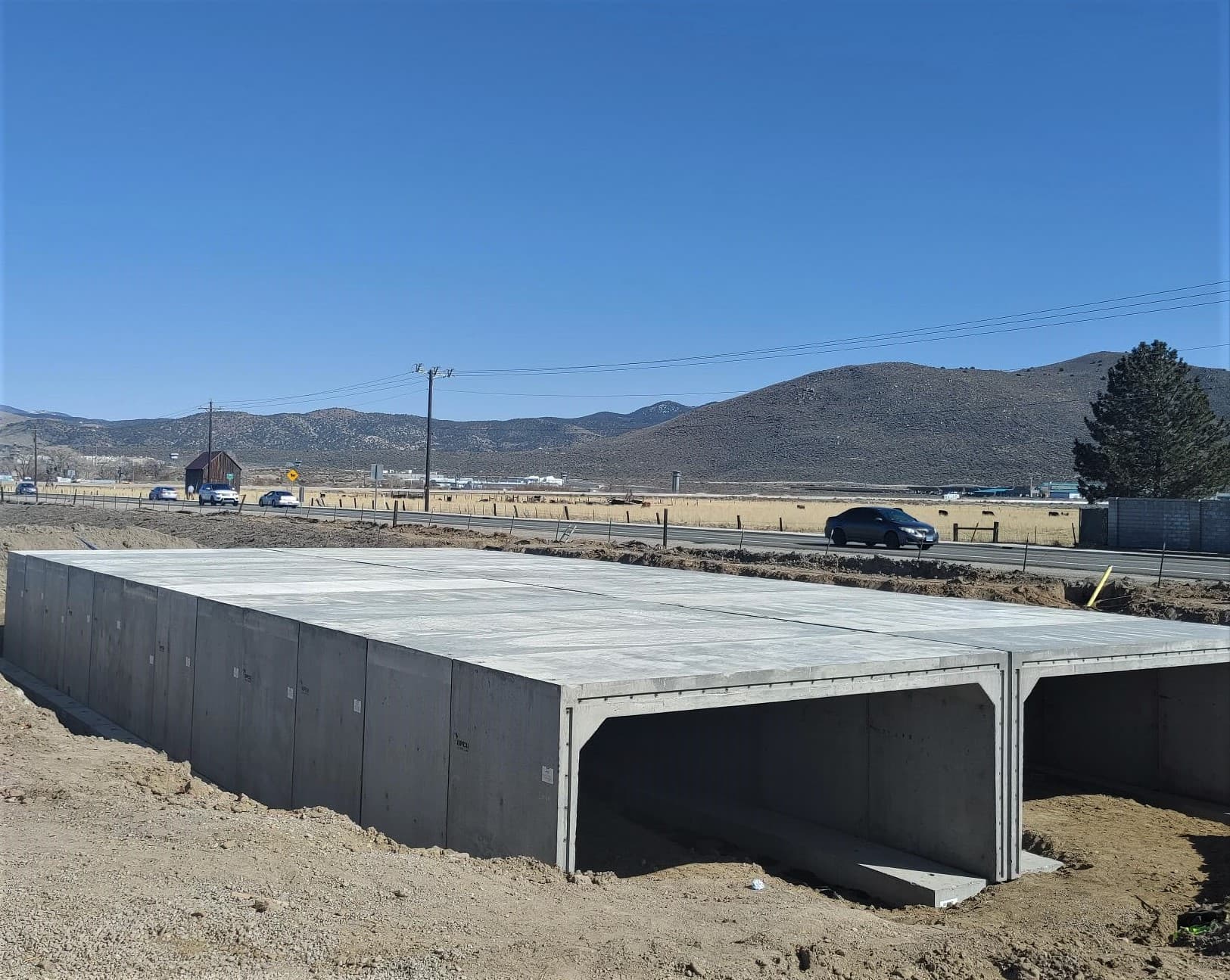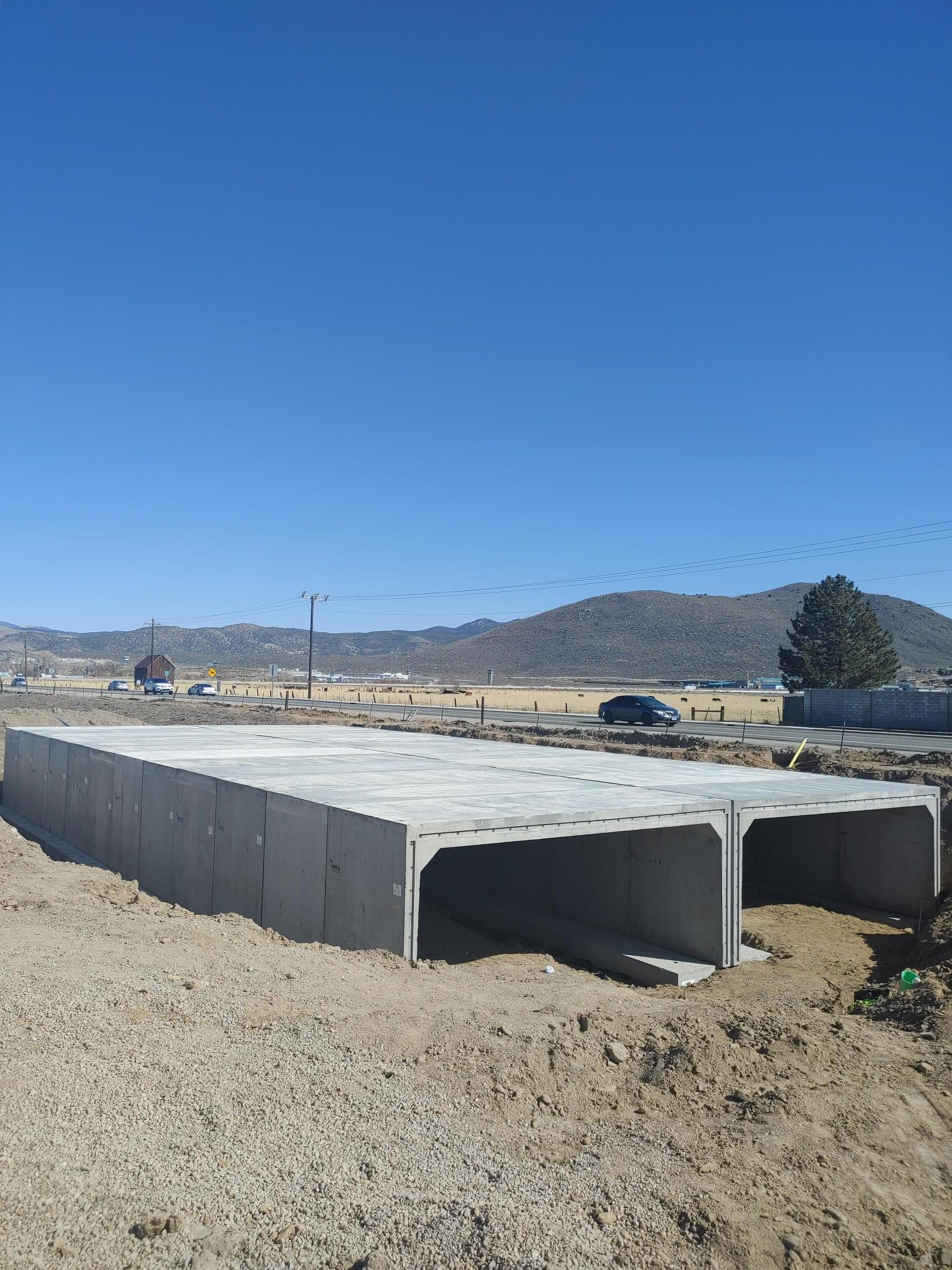Jumbo Box Culvert Bridges Stormwater Channels
Carson City, Nevada
When Sam and Eva Lompa purchased 820 acres of Carson City land in 1936 to raise livestock, the capital of Nevada had a post mining boom population of less than 2,500. Today the thriving municipality along US Route 395 is home to more than 57,000, and the 413 acre Lompa Cattle Ranch rests in the city center surrounded by growing neighborhoods, schools, and businesses.
On the market since 2006, the ranch sat idle for 10 years before Blackstone Development Group submitted plans for a new mixed use planned community spread out over 251 acres. Lompa Ranch North will feature 189 single family houses and 360 apartment units by Ryder Homes for phase one of the development.
Two wide flood control channels are slated to run through the site, which required approval from the US Army Corps of Engineers. The channels will accommodate higher stormwater volume than normal since the development is located at a lower elevation than the surrounding landscape. Blackstone needed extra large structures to bridge the channels, and precast concrete segmental box culvert systems were selected to do the job.
“The developer reached out to us in 2017 to see if it was even possible to get boxes so big,” says Kellen Easter, Jensen Sales Manager in Sparks, Nevada. “We did some value engineering for them and wrote a quote for the first entrance. We called it the jumbo box culvert product line.”
It took about four years and some intensive logistics to gain all the necessary approvals and coordination for the project. The initial planning turned into reality with the construction of two box culvert bridges over the channels at the north and south entrances of the development by the Jensen manufacturing facility in Lockeford, California.
The north entrance box culvert runs 22’W x 60’L x 8’H. The south features a double barrel box culvert at 44’W x 90’L x 8’H. Each section for the channel entrances weighs in at about 42,000 pounds. Jensen provided eight box culvert pieces for the 60’ run and 24 for the 90’ double barrel run. That’s 504 tons—or more than 1 million pounds—of precast concrete just for the 90’ run.

Precast Solution Saves Time
Jensen proposed the double barrel option to save the contractor, Joy Engineering, from having to pour concrete at the jobsite. “When you pour in place you have to wait for that concrete to cure,” Easter says. “So you basically have an open excavation with all your tooling, forming, and everything sitting there waiting for the concrete to cure to a minimum strength before you can tear out all the formwork and then backfill it. With precast concrete, it’s already at its design strength and you can be driving on it the next day or as soon as you get it paved and backfilled.”
To that end the contractor installed the box culvert in a day. Eric Jones, Project Coordinator for Joy Engineering, says the north entrance installation went smoothly, aided by the precast concrete footings supplied by the Jensen Sparks plant, which were installed in advance. “The first one went really well from my perspective,” Jones says. “I was really impressed with the precast footings option as well as the ease of installation.”
When it was time for the south entrance, the developer went right back to Jensen, according to Easter. “It was such a success that the developer’s engineer sole sourced us for the second phase.”
At 30 feet longer and double wide, the 90’ south entrance box culvert is three times the size of the north entrance. It took ongoing logistical coordination between the Sparks plant, the Lockeford plant, and Joy Engineering to keep the project on track. As the pieces were made, the Lockeford plant shipped them 130 miles to a holding yard near the site. The 24 truckloads of box culvert were staged to deliver just-in-time on the contractor’s signal.
Once everything was lined up and ready to go, it was a plug-and-play operation. “We had the crane set up and were able to pick and set the double structure from one side,” Jones says. “The trucks were lined up, and we were able to knock out the bridge section in one day.”
The ongoing communication between the two Jensen facilities and the contractor paid off at the jobsite, Easter says. “The contractor was able to set one piece every 10 minutes. As long as we had a piece ready to go, they could set it.”
Development of Lompa Ranch will continue through several phases over the next few years. Vertical construction is to start in May 2021 with the building of model homes, followed shortly thereafter by additional home construction.
When your project involves regulatory considerations, such as stormwater mandates, contact us to help you navigate the approval process. Start with a quote request.





